Whirlpool UXW6536BSS1, UXW6530BSS0, UXW6536BSS2, UXW6536BSS0, UXW6536BS0 Owner’s Manual
...
30" AND 36" (76.2 AND 91.4 CM) WALL-MOUNT
CANOPY RANGE HOOD
Installation Instructions and Use & Care Guide
For questions about features, operation/performance, parts, accessories or service, call: 1-800-253-1301 or visit our website at www.whirlpool.com
In Canada, call 1-800-807-6777 or visit our website at www.whirlpool.ca
HOTTE DE CUISINIÈRE À MONTAGE MURAL
DE 30" ET 36" (76,2 ET 91,4 CM)
Instructions d’installation et Guide d’utilisation et d’entretien
Au Canada, pour assistance, installation ou service, composer le 1-800-807-6777 ou visiter notre site Web à www.whirlpool.ca
Table of Contents/Table des matières...................................... |
2 |
IMPORTANT: READ AND SAVE THESE INSTRUCTIONS.
FOR RESIDENTIAL USE ONLY.
IMPORTANT : LIRE ET CONSERVER CES INSTRUCTIONS.
POUR UTILISATION RÉSIDENTIELLE UNIQUEMENT.
LI31GE/W10526059H
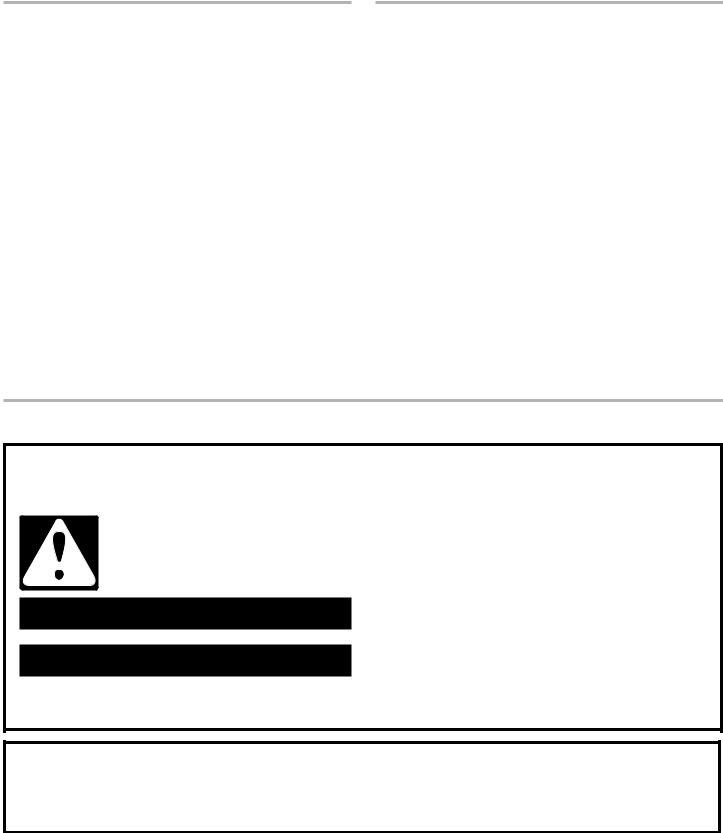
TABLE OF CONTENTS |
|
RANGE HOOD SAFETY.................................................................. |
2 |
INSTALLATION REQUIREMENTS................................................. |
4 |
Tools and Parts............................................................................. |
4 |
Location Requirements................................................................. |
4 |
Venting Requirements................................................................... |
5 |
Electrical Requirements................................................................ |
6 |
INSTALLATION INSTRUCTIONS................................................... |
7 |
Prepare Location........................................................................... |
7 |
Install Range Hood....................................................................... |
8 |
Connect Vent System................................................................... |
8 |
Make Electrical Connection.......................................................... |
9 |
Install Vent Covers........................................................................ |
9 |
Complete Installation.................................................................. |
10 |
RANGE HOOD USE...................................................................... |
10 |
Range Hood Controls................................................................. |
10 |
RANGE HOOD CARE.................................................................... |
11 |
Cleaning...................................................................................... |
11 |
WIRING DIAGRAM........................................................................ |
12 |
ASSISTANCE OR SERVICE.......................................................... |
13 |
In the U.S.A................................................................................. |
13 |
In Canada.................................................................................... |
13 |
Accessories................................................................................. |
13 |
WARRANTY................................................................................... |
14 |
TABLE DES MATIÈRES |
|
SÉCURITÉ DE LA HOTTE DE CUISINIÈRE................................ |
15 |
EXIGENCES D’INSTALLATION.................................................... |
17 |
Outils et pièces........................................................................... |
17 |
Exigences d’emplacement......................................................... |
17 |
Exigences concernant l’évacuation............................................ |
18 |
Spécifications électriques........................................................... |
20 |
INSTRUCTIONS D’INSTALLATION............................................. |
20 |
Préparation de l’emplacement................................................... |
20 |
Installation de la hotte................................................................. |
21 |
Raccordement du circuit d’évacuation...................................... |
22 |
Raccordement électrique........................................................... |
22 |
Installation des cache-conduits.................................................. |
23 |
Achever l’installation................................................................... |
23 |
UTILISATION DE LA HOTTE........................................................ |
24 |
Commandes de la hotte de cuisinière........................................ |
24 |
ENTRETIEN DE LA HOTTE.......................................................... |
24 |
Nettoyage.................................................................................... |
24 |
SCHÉMA DE CÂBLAGE............................................................... |
26 |
ASSISTANCE OU SERVICE.......................................................... |
27 |
Au Canada.................................................................................. |
27 |
Accessoires................................................................................. |
27 |
GARANTIE..................................................................................... |
27 |
RANGE HOOD SAFETY
Your safety and the safety of others are very important.
many important safety messages in this manual and on your appliance. Always read and obey all safety
safety alert symbol.
alerts you to potential hazards that can kill or hurt you and others.
messages will follow the safety alert symbol and either the word “DANGER” or “WARNING.” mean:
 DANGER
DANGER  WARNING
WARNING
You can be killed or seriously injured if you don't immediately follow instructions.
You can be killed or seriously injured if you don't follow instructions.
All safety messages will tell you what the potential hazard is, tell you how to reduce the chance of injury, and tell you what can happen if the instructions are not followed.
State of California Proposition 65 Warnings:
WARNING: This product contains one or more chemicals known to the State of California to cause cancer.
WARNING: This product contains one or more chemicals known to the State of California to cause birth defects or other reproductive harm.
2
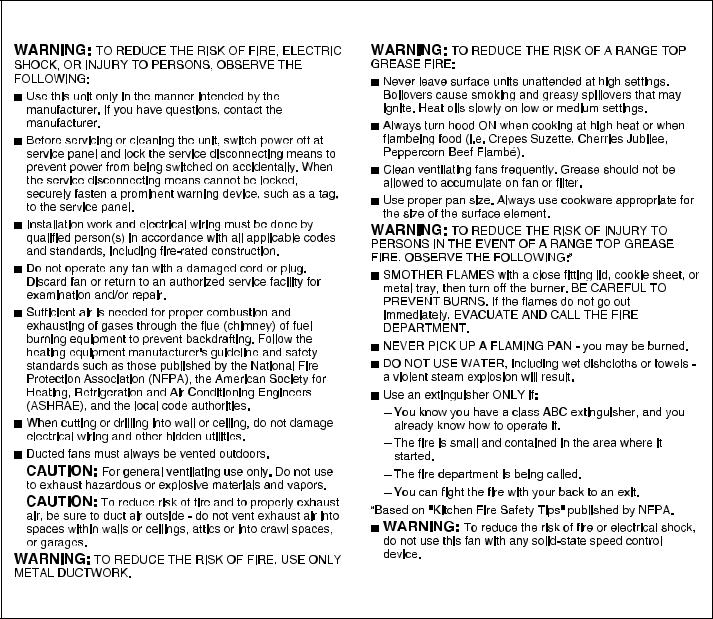
IMPORTANT SAFETY INSTRUCTIONS |
READ AND SAVE THESE INSTRUCTIONS |
3
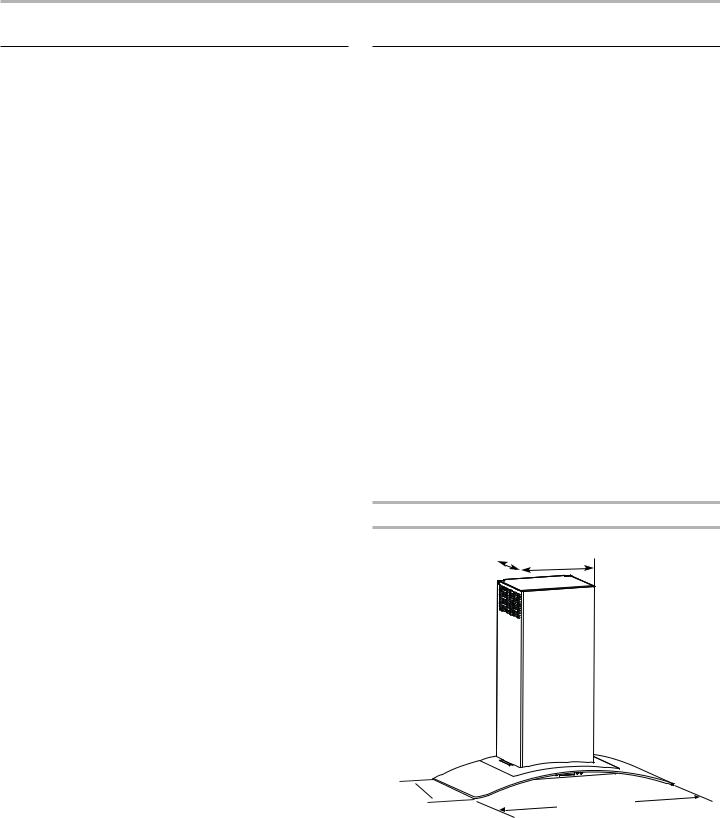
INSTALLATION REQUIREMENTS
Tools and Parts
Gather the required tools and parts before starting installation. Read and follow the instructions provided with any tools listed here.
Tools Needed
■■ Level
■■ Drill with 11/4" (3.2 cm), 1/8" (3.2 mm), and 5/16" (7.9 mm) drill bits
■■ Pencil
■■ Wire stripper or utility knife ■■ Tape measure or ruler
■■ Pliers
■■ Caulking gun and weatherproof caulking compound ■■ Vent clamps
■■ Jigsaw or keyhole saw ■■ Flat-blade screwdriver ■■ Metal snips
■■ Phillips screwdriver
Parts Needed
■■ |
Home power supply cable |
■■ |
1/2" (12.7 mm) UL listed or CSA approved strain relief |
■■ 3 UL listed wire connectors
For Vented Installations, You Will Also Need:
■■ 1 wall or roof cap
■■ Metal vent system
For Non-Vented (Recirculating) Installations, You Will Also Need:
■■ Recirculation Kit Part Number W10294733 for non-vented (recirculating) installations only. See “Assistance or Service” section to order.
■■ 6" (15.2 cm) diameter round metal vent duct - length required is determined by ceiling height.
Parts Supplied
Remove parts from packages. Check that all parts are included.
■■ Hood canopy assembly with blower, lights and canopy glass already installed.
■■ Vent transition with back draft dampers installed ■■ Metal grease filter
■■ Vent cover support bracket ■■ Mounting template
■■ 2-piece vent cover
■■ 4 - 4.2 x 8 mm screws
■■ 6 - 5 x 45 mm mounting screws ■■ 2 - 3.5 x 9.5 mm mounting screws ■■ 2 - 8 x 40 mm wall anchors
■■ 4 - 10 x 60 mm wall anchors
■■ 4 - 5.4 x 75 mm screws (for 10 x 60 mm wall anchors) ■■ T10 Torx®† adapter
■■ T20®† Torx® adapter
Location Requirements
IMPORTANT: Observe all governing codes and ordinances.
Have a qualified technician install the range hood. It is the installer’s responsibility to comply with installation clearances specified on the model/serial/rating plate. The model/serial/ rating plate is located behind the left filter on the rear wall
of the vent hood.
Canopy hood location should be away from strong draft areas, such as windows, doors and strong heating vents.
Cabinet opening dimensions that are shown must be used. Given dimensions provide minimum clearance.
This range hood is recommended for use with cooktops with a maximum total rating of 60,000 BTUs or less.
Grounded electrical outlet is required. See “Electrical Requirements” section.
The canopy hood is factory set for venting through the roof or wall. For non-vented (recirculating) installation see “For nonvented (recirculating) installation only” in the “Connect Vent System” section. Recirculation Kit Part Number W10294733 is available from your dealer or an authorized parts distributor.
All openings in ceiling and wall where canopy hood will be installed must be sealed.
For Mobile Home Installations
The installation of this range hood must conform to the Manufactured Home Construction Safety Standards, Title 24 CFR, Part 328 (formerly the Federal Standard for Mobile Home Construction and Safety, Title 24, HUD, Part 280)
or when such standard is not applicable, the standard for Manufactured Home Installation 1982 (Manufactured Home Sites, Communities and Setups) ANSI A225.1/NFPA 501A, or latest edition, or with local codes.
Product Dimensions
10⁄" |
13³⁄" |
||
(27.6 cm) |
|||
(33.5 cm) |
|||
|
|
||
|
|
|
|
|
|
|
|
20" 
(50.8 cm)  30" (76.2 cm) or 36" (91.4 cm)
30" (76.2 cm) or 36" (91.4 cm)
†®TORX and T20 are registered trademarks of Acument Intellectual Properties, LLC.
4
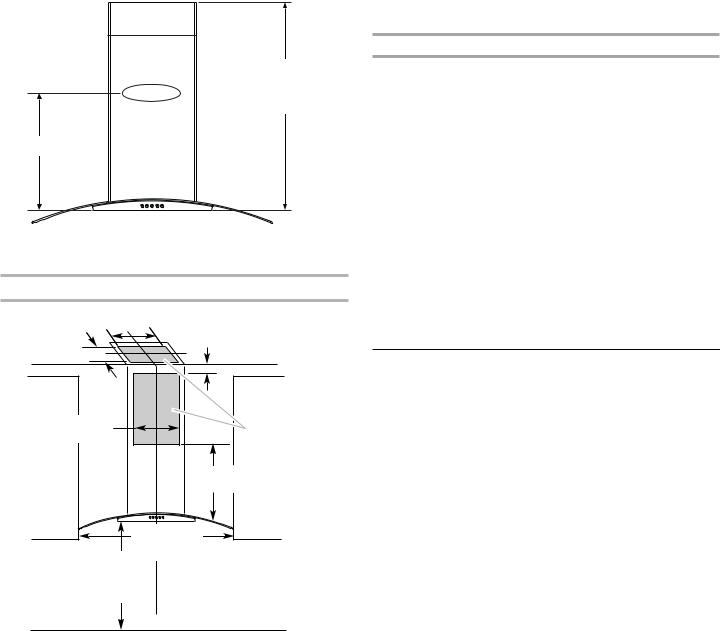
**27¹⁄ " (68.9 cm) min. **41¹⁄ " (104.5 cm) max.
*27¹⁄ " (68.9 cm) min.
*45¹⁄ " (115.6 cm) max.
17³⁄ " (43.7 cm)
*For non-vented (recirculating) installations
**For vented installations
Cabinet Dimensions
10" (25.4 cm) min. 13" (33.0 cm) max.
2" (5.1 cm) min. 9" (22.9 cm) min.*
9¹⁄ " (24.1 cm)
10" (25.4 cm) min. |
Vent and power |
supply cable |
|
13" (33.0 cm) max. |
entry location |
|
20" (50.8 cm)* min. |
Side |
Side |
cabinet |
cabinet |
|
30" (76.2 cm) or |
|
36" (91.4 cm) |
“X” bottom of canopy to cooking surface
Centerline
Cooking surface
* For non-vented (recirculating) installations
IMPORTANT:
Minimum distance “X”: 24" (61 cm) from electric cooking surface
Minimum distance “X”: 27" (68.6 cm) from gas cooking surface
Suggested maximum distance “X”: 36" (91.4 cm)
The chimneys can be adjusted for different ceiling heights. See the following chart.
Vented Installations
|
Min. ceiling height |
Max. ceiling height |
|
|
|
Electric cooking |
7' 4" (2.23 m) |
9' 5" (2.87 m) |
surface |
|
|
Gas cooking |
7' 7" (2.31 m) |
9' 5" (2.87 m) |
surface |
|
|
Non-Vented (Recirculating) Installations |
||
|
|
|
|
Min. ceiling height |
Max. ceiling height |
|
|
|
Electric cooking |
7' 4" (2.23 m) |
9' 9" (2.97 m) |
surface |
|
|
Gas cooking |
7' 7" (2.31 m) |
9' 9" (2.97 m) |
surface |
|
|
NOTE: The range hood chimneys are adjustable and designed to meet varying ceiling or soffit heights depending on the distance “X” between the bottom of the range hood and the cooking surface. For higher ceilings, a Stainless Steel Chimney Extension Kit Part Number W10294735 is available from your dealer or an authorized parts distributor. The chimney extension replaces the upper chimney shipped with the range hood.
Venting Requirements
(vented models only)
■■ Vent system must terminate to the outdoors except for non-vented (recirculating) installations.
■■ Do not terminate the vent system in an attic or other enclosed area.
■■ Do not use 4" (10.2 cm) laundry-type wall cap.
■■ Use metal vent only. Rigid metal vent is recommended. Plastic or metal foil vent is not recommended.
■■ The length of vent system and number of elbows should be kept to a minimum to provide efficient performance.
For the Most Efficient and Quiet Operation:
■■ Use no more than three 90° elbows.
■■ Make sure there is a minimum of 24" (61 cm) of straight vent between the elbows if more than 1 elbow is used.
■■ Do not install 2 elbows together.
■■ Use clamps to seal all joints in the vent system.
■■ The vent system must have a damper. If the roof or wall cap has a damper, do not use the damper supplied with the range hood.
■■ Use caulking to seal exterior wall or roof opening around the cap.
■■ The size of the vent should be uniform.
Cold Weather Installations
An additional back draft damper should be installed to minimize backward cold air flow and a thermal break should be installed to minimize conduction of outside temperatures as part of the vent system. The damper should be on the cold air side of the thermal break.
The break should be as close as possible to where the vent system enters the heated portion of the house.
5

Makeup Air
Local building codes may require the use of makeup air systems when using ventilation systems greater than specified CFM of air movement. The specified CFM varies from locale to locale. Consult your HVAC professional for specific requirements in your area.
Venting Methods
This canopy hood is factory set for venting through the roof or wall.
A 6" (15.2 cm) round vent system is needed for installation
(not included). The hood exhaust opening is 6" (15.2 cm) round.
NOTE: Flexible vent is not recommended. Flexible vent creates back pressure and air turbulence that greatly reduce performance.
Vent system can terminate either through the roof or wall. To vent through a wall, a 90° elbow is needed.
Rear Discharge
A 90° elbow may be installed immediately above the hood.
For Non-Vented (Recirculating) Installations
If it is not possible to vent cooking fumes and vapors to the outside, the hood can be used in the non-vented (recirculating) version, fitting a charcoal filter and the deflector. Fumes and vapors are recycled through the top grille.
|
|
Non-Vented |
Roof Venting |
Wall Venting |
(Recirculating) |
|
|
A |
A |
|
|
|
B |
|
B |
|
|
B |
|
|
A |
A. Roof cap |
A. Wall cap |
A. Deflector |
B. 6" (15.2 cm) |
B. 6" (15.2 cm) |
B. 6" (15.2 cm) |
round vent |
round vent |
round vent |
|
|
|
Calculating Vent System Length
To calculate the length of the system you need, add the equivalent feet (meters) for each vent piece used in the system.
Vent Piece |
6" (15.2 cm) Round |
|
|
45° elbow |
2.5 ft (0.8 m) |
90° elbow |
5 ft (1.5 m) |
Maximum equivalent vent length is 35 ft (10.7 m).
Example Vent System
90 elbow |
|
|
|
|
|
|
Wall cap |
||
|
|
6 ft (1.8 m) |
|
|
|||||
|
|
|
|
|
|
||||
|
|
|
|
|
|
|
|
|
|
|
|
|
|
|
|
|
|
|
|
|
|
|
|
|
|
|
|
|
|
2 ft
(0.6 m)
The following example falls within the maximum recommended vent length of 35 ft (10.7 m).
1 |
- 90° elbow |
= 5 ft (1.5 m) |
1 |
- wall cap |
= 0 ft (0 m) |
8 ft (2.4 m) straight |
= 8 ft (2.4 m) |
|
|
|
|
Length of system |
= 13 ft (3.9 m) |
|
Electrical Requirements
Observe all governing codes and ordinances.
Ensure that the electrical installation is adequate and in conformance with National Electrical Code, ANSI/NFPA 70 (latest edition), or CSA Standards C22.1-94, Canadian
Electrical Code, Part 1 and C22.2 No. 0-M91 (latest edition) and all local codes and ordinances.
If codes permit and a separate ground wire is used,
it is recommended that a qualified electrician determine that the ground path is adequate.
A copy of the above code standards can be obtained from:
National Fire Protection Association
1 Batterymarch Park
Quincy, MA 02169-7471
CSA International
8501 East Pleasant Valley Road
Cleveland, OH 44131-5575
■■ A 120 volt, 60 Hz., AC only, 15-amp, fused electrical circuit is required.
■■ If the house has aluminum wiring, follow the procedure below:
1.Connect a section of solid copper wire to the pigtail leads.
2.Connect the aluminum wiring to the added section of copper wire using special connectors and/or tools
designed and UL listed for joining copper to aluminum.
Follow the electrical connector manufacturer’s recommended procedure. Aluminum/copper connection must conform with local codes and industry accepted wiring practices.
■■ Wire sizes and connections must conform with the rating of the appliance as specified on the model/serial/rating plate. The model/serial/rating plate is located behind the left filter on the rear wall of the range hood.
■■ Wire sizes must conform to the requirements of the National Electrical Code, ANSI/NFPA 70 (latest edition), or CSA Standards C22. 1-94, Canadian Electrical Code, Part 1
and C22.2 No. 0-M91 (latest edition) and all local codes and ordinances.
6

INSTALLATION INSTRUCTIONS
Prepare Location
■■ It is recommended that the vent system be installed before hood is installed.
■■ Before making cutouts, make sure there is proper clearance within the ceiling or wall for exhaust vent.
■■ Check your ceiling height and the hood height maximum before you select your hood.
1.Disconnect power.
2.Determine which venting method to use: roof, wall, or non-vented.
3.Select a flat surface for assembling the range hood. Place covering over that surface.
 WARNING
WARNING
Excessive Weight Hazard
Use two or more people to move and install range hood.
Failure to do so can result in back or other injury.
4.Using 2 or more people, lift range hood onto covered surface.
Range Hood Mounting Screws Installation
1.Determine and mark the centerline on the wall where the canopy hood will be installed.
2.Select a mounting height between a minimum of 24" (61 cm) for an electric cooking surface, a minimum of 27" (68.6 cm) for a gas cooking surface, and a suggested maximum of 36" (91.4 cm) above the range to the bottom of the hood. Mark a reference line on the wall.
3.Tape template in place, aligning the template centerline and bottom of template with hood bottom line and with the centerline marked on the wall.
A
DRILL 2 (TWO) 3/16" PILOT HOLES THROUGH STUDS OR REAR WALL SUPPORT
Centerlin Vertical
REAR WALL
MOUNTING TEMPLATE
CL
ALIGN BOTTOM EDGE
WITH PENCIL LINE
INDICATING BOTTOM
OF THE HOOD
Installation Height
Horizontal Line
B C
A.Centerline
B.Fastener locations
C.Mounting height reference (hood bottom line)
4.Mark centers of the fastener locations through the template to the wall.
IMPORTANT: All canopy mounting screws must be installed into wood where possible. If there is no wood to screw into, additional wall framing supports may be required, or use the (4) 10 x 60 mm wall anchors and 5.4 x 75 mm screws. Remove the template.
5.For wood, drill 3/16" (4.8 mm) pilot holes at all locations where screws are being installed into wood.
For wall anchors, drill 7/16" (10 mm) holes at all locations where wall anchors are being used.
6.For wood, install (2) 5 x 45 mm mounting screws. Leave a 1/4" (6.4 mm) gap between the wall and the back of the screw head to slide range hood into place.
For wall anchors, install the 10 x 60 mm wall anchors and install the 5.4 x 75 mm screws into the wall anchors.
Tighten until the wall anchors are secure. Back the screws out 1/4" (6.4 mm).
¹⁄" (6.4 mm)
Vent Cover Bracket Installation
7.Attach vent cover bracket to wall flush to the ceiling using (2) 5 x 45 mm screws. Use the optional wall anchors if needed.
 A
A
B
C
A.Ceiling
B.Wall
C.Centerline
Complete Preparation
1.Determine and make all necessary cuts in the wall for the vent system. Install the vent system before installing the hood. See “Venting Requirements” section.
2.Determine the required height for the home power supply cable and drill a 11/4" (3.2 cm) hole at this location.
3.Run the home power supply cable according to the National Electrical Code or CSA Standards and local codes and ordinances. There must be enough 1/2" conduit and wires from the fused disconnect (or circuit breaker) box to make the connection in the hood’s electrical terminal box.
NOTE: Do not reconnect power until installation is complete.
4.Use caulk to seal all openings.
7
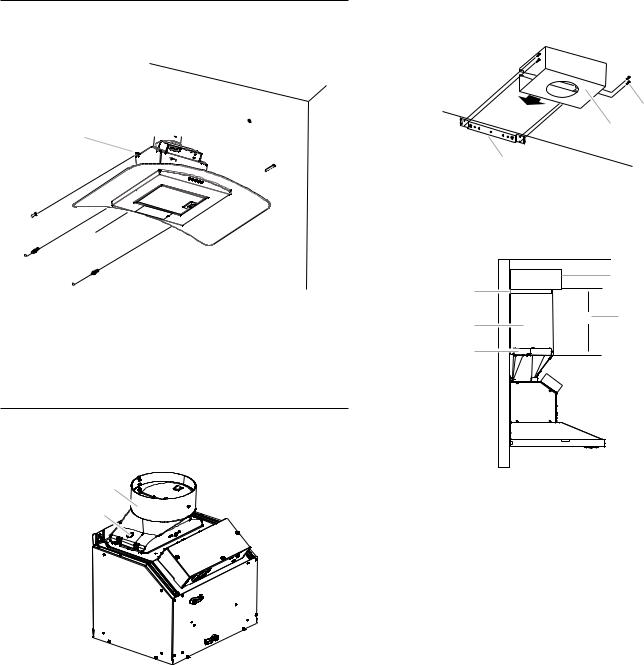
Install Range Hood
1.Using 2 or more people, hang range hood on 2 mounting screws through the mounting slots on back of hood.
B 

 C
C
A

A.Mounting screws
B.Mounting slots
C.Lower mounting screws
2.Remove the grease filter. See “Range Hood Care” section.
3.Level the range hood and tighten upper mounting screws.
4.Install (2) 5 x 45 mm lower mounting screws and tighten. Use the optional wall anchors if needed.
ConnectVent System
1.Install transition on top of hood (if removed for shipping) with (2) 3.5 x 9.5 mm sheet metal screws.
A
B
A.Vent transition
B.3.5 x 9.5 mm screw
For vented installations only:
1.Fit vent system over the exhaust outlet.
2.Seal connection with clamps.
3.Check that back draft dampers work properly.
For non-vented (recirculating) installation only:
1.Assemble the air deflector with the duct cover bracket using (4) 4.2 x 8 mm screws.
A
B
C
A.Assembly screws
B.Air deflector
C.Duct cover bracket
2.Measure from the bottom of the air deflector to the bottom of the hood outlet.
|
|
A |
B |
|
|
D |
X |
C |
|
|
|
E |
|
|
A.Air deflector
B.Vent clamp
C.X = length to cut vent duct
D.Vent duct
E.Exhaust outlet
3.Cut the duct to the measured size “X.”
4.Remove the air deflector.
5.Slide the duct onto the bottom of the air deflector.
6.Place the assembled air deflector and duct over the exhaust outlet from the hood.
7.Reassemble the air deflector to the duct cover bracket with the 4 assembly screws.
8.Seal connections with vent clamps.
8

Make Electrical Connection
 WARNING
WARNING
Electrical Shock Hazard Disconnect power before servicing.
Replace all parts and panels before operating.
Failure to do so can result in death or electrical shock.
1.Disconnect power.
2.Remove terminal box cover.
3.Remove the knockout in the terminal box and install a UL listed or CSA approved 1/2" strain relief.
C
B
A
A.Terminal box
B.Knockout
C.Terminal box cover
4.Run home power supply cable through strain relief into terminal box.
A
 B
B
 C
C
|
F E |
D |
|
|
|
G |
|
|
A. Home power supply cable |
D. White wires |
|
B. UL listed or CSA |
E. Black wires |
|
approved strain relief |
F. Green (or bare) and |
|
C. UL listed wire connectors |
yellow-green ground wires |
|
G. Terminal box
5.Use UL listed wire connectors and connect black wires (E) together.
6.Use UL listed wire connectors and connect white wires (C) together.
 WARNING
WARNING
Electrical Shock Hazard Electrically ground blower.
Connect ground wire to green and yellow ground wire in terminal box.
Failure to do so can result in death or electrical shock.
7.Connect green (or bare) ground wire from home power supply to yellow-green ground wire (F) in terminal box using UL listed wire connectors.
8.Tighten strain relief screw.
9.Install terminal box cover.
10.Check that all light bulbs are secure in their sockets.
11.Reconnect power.
InstallVent Covers
1.When using both upper and lower vent covers, push lower cover down onto hood and lift upper cover to ceiling and install with (2) 4.2 x 8 mm screws.
B
A
 C
C
A.Bracket
B.4.2 x 8 mm screws
C.Vent cover
NOTE: For vented installations, the upper vent cover may be reversed to hide slots.
9
